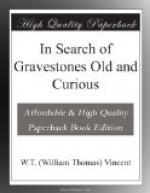Fig. 18.—At Meopham.
“To Sarah Edmeades, died 1728, aged 35 years.”
In the churchyards of Hawkhurst, Benenden, Bodiam, Cranbrook, Goudhurst, and all through the Great Weald these incised stones are to be discovered by hundreds, very much of one type perhaps, but displaying nevertheless some extraordinary variations. I know of no district so fruitful of these examples as the Weald of Kent.
Even when the rude system of cutting into the stone ceased to be practised and relief carving became general, grossness of idea seems to have survived in many rural parishes. One specimen is to be seen in the churchyard of Stanstead in Kent, and is, for relief work, childish.
FIG. 19.—AT STANSTEAD.
“To William Lock, died 1751, aged 16 years.”
However, the vast number of gravestones carved in relief are, on the whole, creditable, especially if we consider the difficulty which met the workmen in having to avoid giving to their crossbones and other ornaments the appearance of horns growing out of their skulls.
[Illustration: Fig. 18. Meopham.]
[Illustration: Fig. 19. Stanstead.]
[Illustration: Fig. 20. Old Romney.]
[Illustration: Fig. 21. Crayford.]
[Illustration: Fig. 22. Shoreham.]
[Illustration: Fig. 23. Lewisham.]
[Illustration: Fig. 24. HOBNSEY.]
Fig. 20.—At old Romney.
“To William Dowll, died 1710, aged 40 years.”
The winged skull probably typifies flight above.
Fig. 21.—At Crayford.
“To John Farrington, died Dec.
8, 1717, aged
above fourty years.”
In the appropriate design from Shoreham the same idea is better conveyed both by the winged head and by the torch, which when elevated signifies the rising sun, and when depressed the setting sun. The trumpet in this case would seem to mean the summons. The two little coffins are eloquent without words.
Fig. 22.—At Shoreham.
“The children of Thomas and
Jane Stringer,
died Sept’r 1754, aged 10 and 7 years.”
In Lewisham Churchyard is one of the death’s head series almost sui generis.
Fig. 23.—At Lewisham.
“To Richard Evens, died May
18, 1707, aged
67 years.”
The chaplet of bay-leaves or laurel doubtless indicates “Victory.” Not only is this an early and well-accomplished effort, but it is remarkable for the presence of a lower jaw, which is seldom seen on a gravestone. The skull turned up by the sexton is usually the typical object, and to that we may presume the nether jaw is not often attached. It is found, however, on a headstone of a somewhat weak design in Old Hornsey Churchyard.




